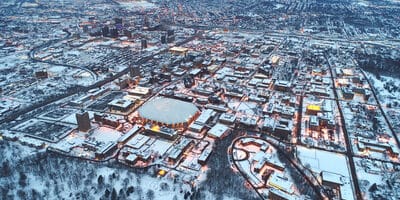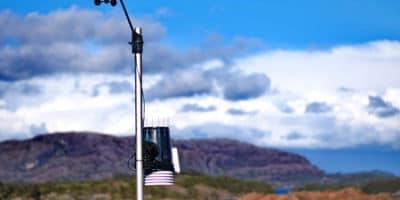
A weather radar is an essential tool in the meteorologist’s toolbox, it allows them to detect precipitation and forecast the weather. Like satellite imagery of clouds, radar helps meteorologists better understand the weather around them, resulting in more reliable forecasts.
Radar (short for RAdio Detection And Ranging) and its use in weather was actually discovered by accident. With the increasing use of radar to detect enemy ships and planes during World War II, radar operators found precipitation also caused false echoes on their screens.
Military radars were repurposed for meteorological use after WWII, and subsequent upgrades enhanced their precipitation-detecting capabilities. Today’s weather radar imagery you find in your weather radar app is far different from those first radars of the 1950s, but the core concepts are the same.
How Modern Weather Radar Works
All radars operate in a similar fashion, no matter their technology. An antenna emits a beam of radio waves outwards. If there are objects in the air like rain, sleet, or snow, the emitted radio waves bounce off those objects and scatter. Some of these scattered radio waves are reflected back to the radar, with larger objects reflecting more.
Differences in reflectivity are plotted on a map to provide a view of precipitation falling within the range of the radar, providing the image you see on TV, the web, and your radar app.
How Does Doppler Radar Work?
Doppler radar works a little bit differently from older radars. Instead of merely just measuring the reflectivity of precipitation, it also detects the shape, position, and form as well. By measuring this, a Doppler radar can also measure the velocity of the movement of precipitation toward or away from the radar.
This allows Doppler radars to measure wind speed, making them extraordinarily useful in detecting tornadoes. Before, meteorologists had to look for visual cues, called a “hook echo,” in order to find tornadoes within storms. Since not every tornado will produce these hook echoes, many were missed.

Doppler radar emits pulses of radio waves and listens for any returned signal. (Image Credit: NOAA)
You experience these “Doppler shifts” on a daily basis. Think about sitting at a light to allow an emergency vehicle to pass, or at a railroad crossing as a train goes by blaring its whistle. You’ll notice that the pitch sound rises as it approaches, is steady as it’s in front of you, and lowers in pitch as it moves away.
That’s the Doppler effect in action, and those shifts are what a doppler radar tries to detect.
Dual-Polarization Radar
Dual-polarization radar is an upgrade to Doppler radar which enhances its detection abilities. Instead of just sending out radio waves in a horizontal direction, “dual-pol” radars send out radio waves both horizontally and vertically.

(Image Credit: NOAA)
The benefits of this is an enhanced ability to detect the shape of objects in the atmosphere. This allows meteorologists to differentiate between precipitation types, and even identify ground debris in the air. The image below shows how dual polarization has helped to confirm when a tornado is on the ground.

(Image Credit: NOAA)
Before dual-polarization, we’d only have the velocity data on the left, which would allow us to suspect a tornado on the ground, but not confirm it without a ground spotter. The image on the right is called correlation coefficient, and the small circular blue area indicates an area of clear air encircled by objects detected in the air (the green color) and similarly shaped raindrops (shown in red). This is called a “debris ball,” and it's a telltale sign on a dual-pol radar of a tornado on the ground.
What’s Next for Weather Radar
As we’ve said already, radars have revolutionized weather forecasting, especially when it comes to severe weather. And meteorologists aren’t stopping with Doppler radar: new technologies like phased array radar will improve detection, and also dramatically increase scan times. Instead of the 2-6 minutes each scan takes now in the Doppler radar system, phased array will be able to scan the same area in under a minute.
However, phased array radar is expected to cost billions of dollars to implement, and with dual-polarization recently launched, it's unlikely to occur until well into the next decade.




